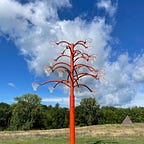The Diner: Putting Human Connection on the Menu
For the last twenty years, my mother has frequented a diner on the Upper West Side of Manhattan near her home. It’s called Cafe 82. Given the vast array of excellent eateries in the neighborhood, I was always puzzled by her devotion to this establishment, a modest one not known for its cuisine or decor.
As time has passed, and I’ve shared more meals with my mother at the diner, I’ve slowly come to understand its lure.
Like an old friend who accepts you as you are and extends a helping hand, the diner provides companionship, care and compassion. That’s a rarity in today’s world.
My mother Sarah is 92 and lives alone, fiercely and proudly. She makes an effort every day to walk the four blocks to the diner and the four blocks back. Most days that’s all she goes out for, aside from doctor visits and occasional meals with family. Her mode of transport to get there has shifted over the years: initially her own two legs, then a cane, then a walker, and now a walker with a companion. What hasn’t changed is that unless it’s pouring, snowing or beastly hot, she makes the trip.
Sarah is a regular and she’s treated like family. The attentive staff members greet her warmly when she arrives with a “Hello, Sarita!”
She knows their names too, and sometimes their stories. Several, maybe most, were born abroad like her. The owner, for one, is an immigrant. He opened the diner so his kids could have the opportunities he couldn’t back home.
But there’s more. The staff save a seat for her when it gets busy and accommodate her in thoughtful ways. You see, Sarah has a condition that makes her hands shake, and that can make eating challenging.
As her essential tremor has deteriorated over the years, it’s become harder for her to manage certain tasks and foods. The diner staff uses a range of strategies to put her at ease. Her coffee comes ¾ full with a side of ice and a straw. Her food is cut up into bite size pieces so she can eat with a single utensil. The whole staff is clued in and serves her in this special way, without fanfare. It nearly brought tears to my eyes when I saw how these small gestures eased her burden and made her feel like she truly belonged.
Sarah has made friends and met friends at the diner. Many are older folks like her, who are comfortable dining alone there because they know they’ll be well received and taken care of.
As she has gotten older and frailer, the places that used to serve as her community gathering places lost primacy and relevance in her life, and most of her peers have passed on.
The pandemic made things much worse.
The Jewish Community Center where she once played Canasta weekly shut its doors during the pandemic, as did her synagogue. While she frequented those places from time to time, only the diner provided the daily connection she craved. And of all the pandemic-related disruptions, what impacted her the most were the oppressive isolation and confinement and the absence of lunches at the diner.
As associational life in the U.S. atrophies, it’s easy to overlook the institutions — like the diner — that strengthen America’s social fabric and bring people together. These are the safe spaces where all can feel welcome, get to know one another, and build trust and connection.
I am curious what places play this social weaving and knitting role in other communities. Do they share certain characteristics? Is it the people who work there, the set-up, the customers, or the context? Are habit and repeated contact the key ingredients?
I want to know so we can bottle this special “diner” sauce, and use it to create many more spaces where people can come together as their whole selves, be invited in and invite others in.
Imagine if we could activate every coffee shop and corner store, every community center and food bank, every hardware store and supermarket, and every library and park with this special sauce!
Some practitioners and thinkers are turning to this question in earnest (see a few listed below). The solution to societal breakdown and our crisis of connection is elusive because the problem is so multifaceted and complex. That means the special sauce will need to contain a number of ingredients: leadership, social norming, inclusive workplace culture, empathy-infused design, and the magic that happens when people are able to share their full humanity with others.
I’ve thought a lot about how to operationalize “belonging.” Yet it was only by sharing lunches at the diner with my mother that I was able to feel the transformational power of an establishment with connection on the menu.
MORE RESOURCES
Belonging Begins With Us (Ad Council campaign)
Ed Levine, Why Diners are More Important than Ever
john a. powell on targeted universalism
Robert D. Putnam and Shaylyn Romney Garrett, The Upswing: How America Came Together a Century Ago and How We Can Do It Again
Weave: The Social Fabric Project at the Aspen Institute
